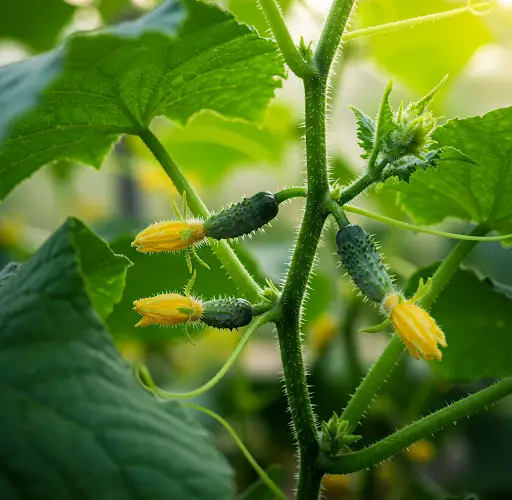High Yield, Lots of Fruit: Growing Baby Cucumbers Upright with Organic Fertilizers and Banana Peels
If you’re looking for a productive, space-saving, and sustainable way to grow cucumbers at home, cultivating baby cucumbers vertically using organic fertilizers and banana peels is an ideal method. This technique not only maximizes yield in a small space but also boosts plant health naturally—without synthetic chemicals.
Baby cucumbers (often known as mini or snack cucumbers) are tender, crisp, and perfect for salads, pickling, or snacking straight from the vine. With the right care and a few simple materials, you can enjoy a steady supply of fresh cucumbers grown right in your backyard, balcony, or even on a rooftop.
Why Grow Baby Cucumbers Vertically?
Vertical gardening is a smart solution for those with limited space. Cucumbers naturally vine and sprawl, but when trained to grow upward, they take up far less ground area while still producing heavily.
Growing cucumbers vertically also provides several benefits:
-
Better air circulation around plants, reducing disease risk
-
Improved fruit quality (less contact with soil = fewer blemishes)
-
Easier harvesting
-
More sunlight exposure for the entire plant
-
Fewer pests like slugs and snails
Combined with organic fertilizers and natural compost from banana peels, this method creates a thriving, high-yield environment.
Materials Needed:
-
Baby cucumber seeds or seedlings
-
A large container or garden bed with good drainage
-
Trellis, bamboo poles, or netting for vertical support
-
Rich potting mix and compost
-
Organic fertilizers (e.g., cow manure, vermicompost)
-
Banana peels
-
Watering can or hose
-
Mulch (optional, for moisture retention)
Step 1: Prepare the Soil
Cucumbers thrive in loose, well-draining soil that’s rich in organic matter. Create a fertile base by mixing the following:
-
50% garden soil or potting mix
-
30% compost (cow dung, vermicompost, or kitchen compost)
-
20% cocopeat or sand for aeration
For a nutrient boost, bury chopped banana peels at the bottom of your planting hole or mix them into the topsoil. Banana peels provide potassium, phosphorus, and calcium—essential nutrients for flowering and fruiting.
If you’re using containers, ensure they’re at least 12 inches deep and have drainage holes. Raised beds work equally well if you’re gardening outdoors.
Step 2: Planting
Plant cucumber seeds ½ inch deep, or transplant healthy seedlings if you’ve started indoors. Space them 12–18 inches apart if planting more than one.
Cucumbers love warmth, so wait until the temperature is consistently above 65°F (18°C) before planting outdoors. Choose a sunny spot—cucumbers need at least 6–8 hours of direct sunlight daily.
Water gently after planting and keep the soil consistently moist, but not soggy.
Step 3: Add Vertical Support
Install a trellis or create a vertical structure using bamboo poles, garden netting, or even strings tied to a frame. Train the vines to climb by gently tying them to the support as they grow.
Vertical supports help prevent diseases by improving airflow and allow the plant to direct more energy into fruit production rather than sprawling growth.
Step 4: Organic Feeding Routine
Feed the plants every 10–14 days with organic fertilizers. Some great options include:
-
Banana peel tea: Soak chopped banana peels in water for 2–3 days, then use the liquid to water your cucumbers.
-
Compost tea: Made by steeping mature compost in water, this provides a balanced nutrient boost.
-
Wood ash: Sprinkle a small amount around the plant base to increase potassium levels.
-
Diluted cow dung slurry or vermicompost extract: Excellent for improving microbial activity in the soil.
Always water the soil before applying any organic fertilizer to prevent root burn and help nutrients absorb more efficiently.
Step 5: Maintenance and Care
Keep the soil consistently moist, especially when the plant starts flowering and fruiting. Mulching with dried leaves or straw around the base can help retain moisture and suppress weeds.
As the plant grows, pinch off any yellowing leaves or suckers (side shoots) near the base to promote better airflow and encourage the plant to focus on fruiting.
Watch for common pests like aphids, spider mites, and cucumber beetles. Spray neem oil or a homemade garlic-chili spray weekly as a natural deterrent.
Step 6: Flowering and Pollination
Baby cucumbers start producing flowers within 4–6 weeks. The first blooms may be male flowers, which don’t bear fruit. Soon after, female flowers (with a tiny fruit at the base) will appear.
If natural pollination is low, use a soft brush to transfer pollen from male to female flowers. This increases fruit set and prevents blossom drop.
Step 7: Harvesting
Baby cucumbers are best harvested when they are 3–5 inches long—firm, green, and glossy. Don’t wait too long, as overripe cucumbers become seedy and bitter.
Use scissors or a small knife to cut the fruit from the vine. Frequent harvesting encourages the plant to continue producing more fruit throughout the season.
Conclusion
With the right combination of vertical growing techniques and organic nutrition, baby cucumbers can become one of the most productive plants in your home garden. By using simple materials like banana peels and natural compost, you support healthy soil and get an abundant harvest without chemicals.
Whether you’re growing in containers, raised beds, or on a small balcony, this method ensures high yield, minimal space use, and a fresh supply of crispy cucumbers all season long.



